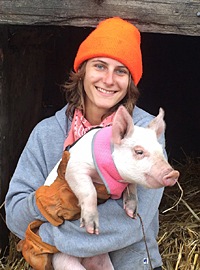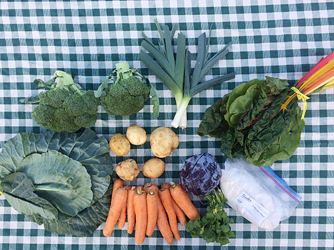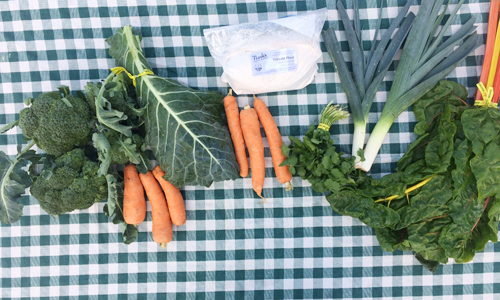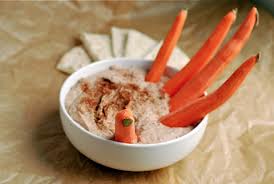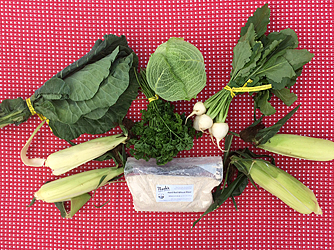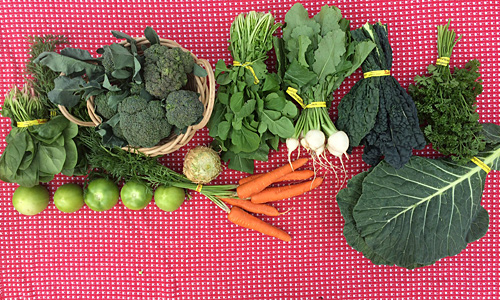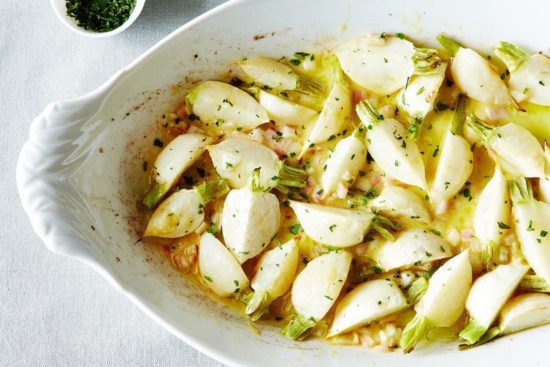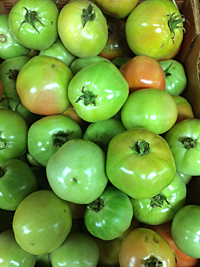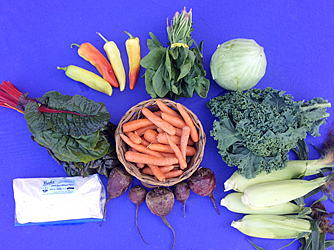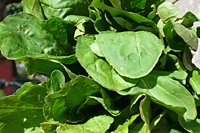In the Standard Box:
Corn 4 ears
Young Leeks 1 bu
Cider 1 qt
Brussels Sprouts 1.5 lb
Spinach 1 bu
Red or Green Savoy Cabbage 1 hd
Chioggia Beets 2 lb
Italian Parsley 1 bu
Broccoli 1.5 lb
Celery Root 1
In the Small Box:
Brussels Sprouts 1.5 lb
Bunched Carrots 1 bu
Spinach 1 bu
Red or Green Savoy Cabbage 1 hd
Chioggia Beets 2 lb
Broccoli 1.5 lb
Celery Root 1
Brussels Sprouts are Back!
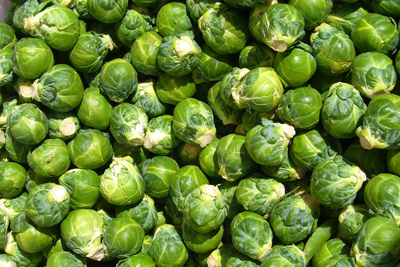
Brussels sprouts are like little baby cabbages. They are not known for being the world’s most favorite vegetable, perhaps because they produce an offensive odor when overcooked, something you should definitely avoid if you want to enjoy their excellent flavor and get the most out of their powerhouse nutrients. The odor comes from a sulfur-containing compound in the Brussels sprouts that is responsible for some pretty impressive health benefits, including fighting cancer.
About 98% of commercial Brussels sprouts in the US is grown in the coastal region of Monterey in California, and almost all of it is frozen. We are fortunate to have great local sprouts that are fresh and organic.
A 1-cup serving contains staggering amounts of vitamins B6, C, and K, as well as manganese, folate, dietary fiber, copper, potassium, and iron, all for only 56 calories. Like other members of the Brassica family, Brussels sprouts pack huge amounts of phytonutrients that are believed to have considerable anticancer and anti-inflammatory properties.
But it’s those sulfur-containing compounds that make Brussels sprouts unique in nutrient content. They are called sulforaphanes and they are found in many cruciferous veggies, like cauliflower, broccoli and cabbage. They actively fight cancer and help to detoxify the body. It’s one of life’s ironies that something so important for our health should sometimes manifest itself in unpleasant ways. However, if you don’t overcook them, Nash’s organic sprouts taste fantastic even prepared simply.
You can steam them and toss them with olive oil, Parmesan cheese, or butter. You can roast them and quarter them, then toss them like a salad with onions, feta cheese, and balsamic vinegar. You can even keep a bowl in the fridge, seasoned with salt and pepper, to snack on throughout the day – their small bite-sized package makes them perfect for popping in your mouth.
Complementary flavors include apples, bacon, caraway seeds, celery root, chervil, nuts, chives, cumin, dill, garlic, ginger, leeks, lemon, mustard, nutmeg, parsley, potatoes, savory, sesame, paprika, thyme and tarragon.
Fun with Brussels Sprouts!
- Brussels sprouts are often at their best when prepared simply with butter or a little cream. Creamed sprouts make a lovely side dish with hearty meats.
- Very thinly sliced Brussels sprouts add unexpected texture and dimension to soups, combine well with other cooked vegetables such as carrots and beets, and, as a raw vegetable, provide crunch and flavor to salads.
- Brussels sprouts have an incredible affinity with the smoked parts of the pig: bacon, ham, pancetta,
lardons—they’re all good.
- For something a little different—and for perfectly cooked Brussels sprouts—try oven-roasting them in culinary parchment paper. This method steams them, and you can insert seasonings inside the paper.
- Brussels sprouts can stand up to strong flavors like citrus, mustard, red wine, garlic, celery, pepper, and ginger.
Brussels Sprouts in Honey Butter
1 pound Brussels sprouts
1 Tbsp. butter, softened
1 Tbsp. honey
2 Tbsp. water
Red chili flakes
Sea salt
Cut each clean sprout in half. In a small bowl, mix the butter with the honey. Heat a wide, flat skillet on medium heat. Add the honey butter and allow it to bubble and melt. Add the sprouts, tossing to coat them with the butter, then arranging them cut side down in a single layer. Cook for 8 to 10 minutes uncovered, until the cut sides turn golden and a little charred. Sprinkle the chili flakes and sea salt to taste over the Brussels sprouts. Stir around so most of them turn over cut side up. Add the water and cook, covered, for another 3 to 5 minutes until they are soft. Serve hot.
— Nithya Das, Foodista.com, as appears in Bounty from the Box: The CSA Farm Cookbook, by Mi Ae Lipe
Chioggia Beets
Chioggia is an actual town in northeast Italy, near Venice, and in the mid-1800s, local farmers there developed a beet that has the most wonderful candy-cane red and white spirals. It also has a mild sweet flavor that lends itself deliciously to salads or crudité. Of course they can be cooked and enjoyed in any way that other beets can, but these guys don’t color everything else in the dish red!
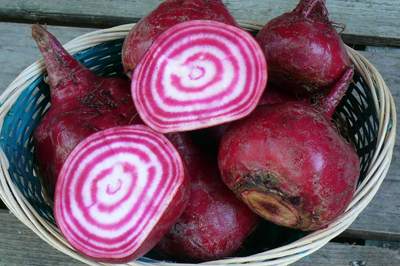
Actually, the colors will fade with heat, but if you want to keep those colors bright when boiling or braising them, toss in a little lemon juice or white vinegar first. Like all your veggies, don’t overcook them to get the maximum health benefits.
Chioggias are rich in fiber, potassium, iron, copper, manganese, magnesium and folic acid, an important B vitamin. Betacyanin, the pigment that gives beets their color, is a powerful antioxidant in Chioggias.
Chioggia beets can be roasted, steamed or braised. Roasting will bring out the most flavor, and they can be served cold or hot. They are a great salad beet, whether served alongside greens or as the main ingredient. They pair well with bacon, apples, cheeses (goat cheese, gorgonzola and aged pecorino in particular), cucumbers, hard-cooked eggs, fennel, mustard, oranges, parsley, smoked fish, shallots, and vinegars, especially balsamic.
Chioggia Beets & Goat Cheese on Toast
4-5 beets, drizzled with olive oil, oven-roasted at 350˚ until tender)
5 oz. goat cheese
2 young leeks, well washed
1 Tbsp. plus 1 tsp. chopped fresh thyme
Sea salt and freshly ground black pepper
5 pieces whole grain bread
Slice leeks into thin rounds and sauté over medium/medium low heat with a splash of olive oil, small pat of butter and sprinkle of salt and pepper until they are soft and translucent.
Mix 1 tablespoon chopped thyme leaves, and a sprinkle of pepper into goat cheese. Stir to soften the cheese.
When beets are cool enough to handle, remove skins and slice very thinly and evenly.
Toast the bread. Cover each slice with sautéed leeks and dot goat cheese evenly on top. Bake 10 minutes at 350° until cheese has softened. Remove from oven and neatly place beet slices on the top, drizzle with a little olive oil, sprinkle with remaining teaspoon chopped thyme leaves and heat in oven until warm, taking care to ensure beets do not dry out. Garnish with a spring of thyme and serve with a green salad.
